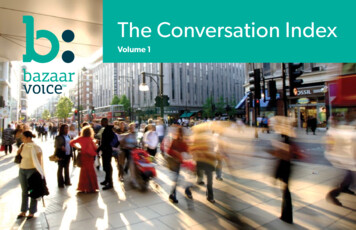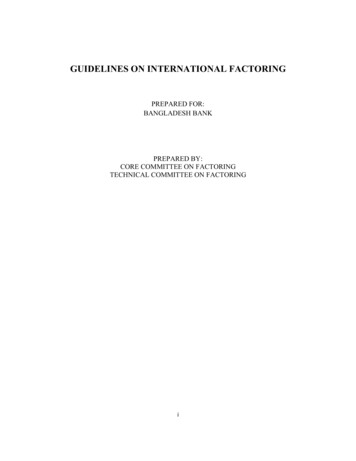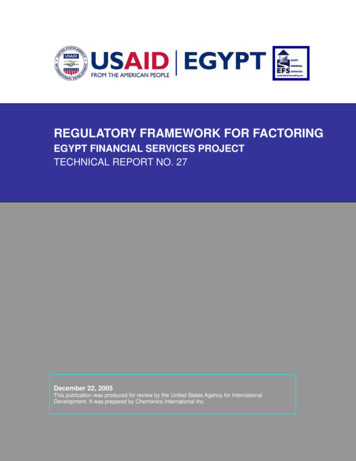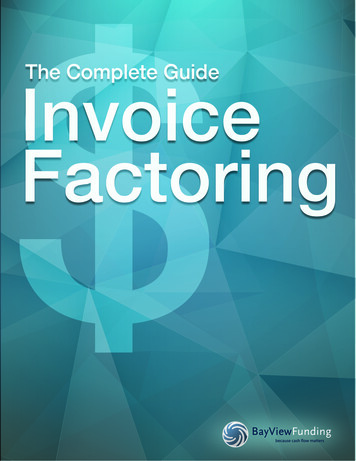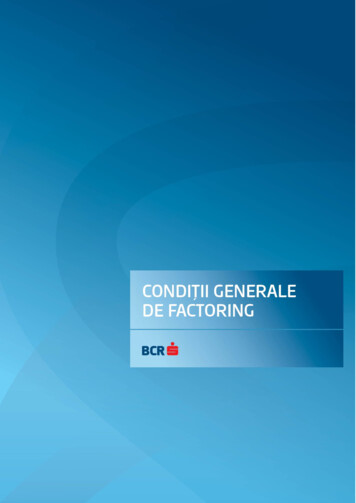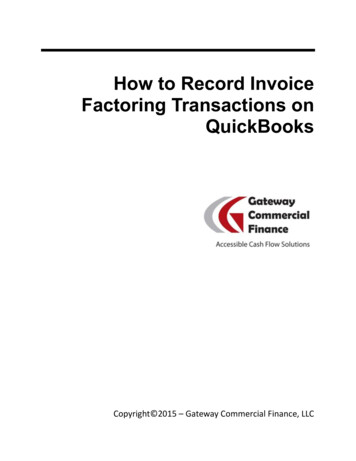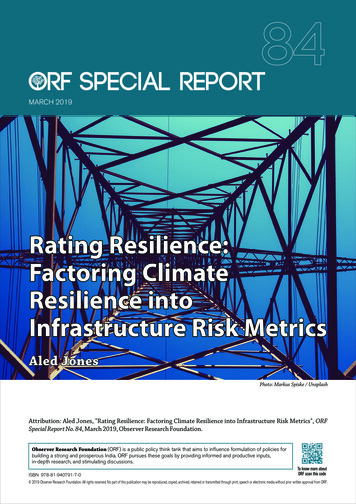
Transcription
MARCH 2019Rating Resilience:Factoring ClimateResilience intoInfrastructure Risk MetricsAled JonesPhoto: Markus Spiske / UnsplashAttribution: Aled Jones, "Rating Resilience: Factoring Climate Resilience into Infrastructure Risk Metrics", ORFSpecial Report No. 84, March 2019, Observer Research Foundation.Observer Research Foundation (ORF) is a public policy think tank that aims to influence formulation of policies forbuilding a strong and prosperous India. ORF pursues these goals by providing informed and productive inputs,in-depth research, and stimulating discussions.ISBN 978-81-940791-7-0 2019 Observer Research Foundation. All rights reserved. No part of this publication may be reproduced, copied, archived, retained or transmitted through print, speech or electronic media without prior written approval from ORF.
Rating Resilience: Factoring Climate Resilience into Infrastructure Risk MetricsABSTRACTThis paper proposes a framework for defining risk metrics to capture climateresilience in infrastructure assets. It first outlines the risks that infrastructureis exposed to under a future of climate change, before summarising some of thecurrent approaches used by large investment organisations to measure theresilience of this infrastructure. Finally, the paper proposes a method todevelop a framework for risk metrics that build on these approaches.BACKGROUNDClimate change is already affecting the weather, ecosystem services and thewell-being of humans and the environment around the world. The number ofextreme weather events and changes to climate events are now increasing atfaster rates, which is further projected to only increase with time. Adapting tothis new future climate and building a resilient infrastructure is vital insustaining our existence (Smith et al., 2001). Previous studies suggest that thelevel of investment needed to adapt to climate change and build resilience couldbe anywhere between US 25 and US 100 billion over the next 20 years, basedon a median climate change scenario (Fankhauser, 2009). Disaster RiskManagement (DRM) has received significant attention in recent years, notleast through the Sendai Framework (Aitsi-Selmi et al., 2015). At the sametime, the number of legal and political mandates for incorporating climatechange information into decision-making is now drawing more attention.The IPCC defines “adaptation” as the “adjustment in natural or humansystems in response to actual or expected climate stimuli and their effects,which moderates harm or exploits beneficial opportunities.” (IPCC, 2007).Conversely, “maladaptation” is commonly defined as a situation that may arisein situations when actions “lead to increased risk of climate-related outcomes,increased vulnerability to climate change, or diminished welfare now or in thefuture.” (IPCC, 2014). Enterprises engaging in adaptation should consider andevaluate the consequences of their actions, both deliberate and inadvertent. Itis also necessary to regularly review these actions as scientific knowledgeimproves, to ensure that adaptation efforts do not unduly compromise orundermine desired objectives or result in unwanted consequences.In recent years, there has been a significant surge in the amount of financeavailable for supporting adaptation, for example, the Green Climate Fund,multi- and bilateral donors, and renewed interest from national governments(Preston et al., 2011; Termeer et al., 2012). As the level of funding has increasedto satisfy the need for adaptation so has the need for comprehensive method2ORF SPECIAL REPORT # 84 MARCH 2019
Rating Resilience: Factoring Climate Resilience into Infrastructure Risk Metricssyntheses and adaptation guidance to (i) ensure adaptation is taking place atthe right time, at the right place and at the right rate; (ii) diagnose and ensureareas of high risk or significant vulnerability are sufficiently addressed; (iii)enable the effective comparison of adaptation projects in space and time; (iv)ensure resources and support for adaptation is being effectively utilised andresulting in tangible action; and (v) inform current gaps and deficiencies inresearch, practice and policy, including governance structures (Pielke et al.,2007; Berrang-Ford et al., 2011; Biesbroek et al., 2013).The use of metrics to inform the management of climate change relatedinvestments is ever increasing. While occasionally, these are driven byindividual firms, most often, they form part of a wider, community-levelapproach. For example, several groups have been set up to facilitate access todata and metrics, including the Global Reporting Initiative (GRI), the AssetOwners Disclosure Project (AODP) and the Carbon Disclosure Project (CDP).Such voluntary initiatives allow investors to collaborate and form coalitions,which have much more impact than individual organisations do. The CDPrepresents investments of over US 100 trillion. However, there is littleevidence that these initiatives have driven real change in either investments orpolicy (Kolk, Levy & Pinske, 2008), although there is some evidence that thereis a learning effect within firms that take part in these reporting initiatives(Matisoff, Noonan & O’Brien, 2013). Historically, such initiatives have focusedon reporting climate change mitigation efforts, not resilience and adaptation.With regards to mitigation, an important policy request from investors hasbeen for a price to be put on carbon (IIGCC, 2011). So far, there has been no realmove towards a global carbon price, although various regions have adoptedpolicies to create local markets for carbon. In the absence of a global carbonprice, the private sector has expressed some reluctance in significantlyincreasing investments due to a perception of increased risk (Jones, 2015). Tocounter some of this perception, the public sector is creating public–privatepartnerships (PPPs) and opportunities for blended finance (Vivid Economics,2014). Investing alongside the public sector will lower the risk and increasemarket opportunities. However, most such PPPs focus on institutionalinvestors, while the largest portion of current investments come fromcorporates and project developers (Vivid Economics, 2014). PPPs are oftenused to explore the development of metrics.The challenge of transforming the investment landscape from a fossil-fueleconomy to a low-carbon one has led many to explore the path-dependentnature of those investments (Lovio et al., 2011). There must be a significantORF SPECIAL REPORT # 84 MARCH 20193
Rating Resilience: Factoring Climate Resilience into Infrastructure Risk Metricsand active process of driving the required change in investment landscape, tomove away from this “carbon lock in.” (Kemp-Benedict, 2014). However, in theabsence of such a drive away from the high-carbon pathway at the scalerequired, there is an increased perception of material financial risk resultingfrom climate change (Jones et al., 2013).Of all asset owners globally, 60 percent—representing US 27 trillion ininvestment—now incorporate some level of climate risk in their decisionmaking processes (Asset Owners Disclosure Project, 2017). This represents asignificant change between 2016 and 2017 with 45 asset owners addingclimate-risk considerations. However, as noted above, the level of investmentinto mitigation does not match the perceived risk. Within US asset owners,only 0.5 percent of investment is channelled towards low-carbon assets (AssetOwners Disclosure Project, 2017).CURRENT PRACTICE IN MEASURING RESILIENCEThere are several methods used to categorise resilience practice. These includeclassifications such as research, plan, networks, legislation, awareness raising,implemented change, training and advocacy (Agrawal & Perrin, 2009) ormigration, storage, diversification, pooling and market exchange (Tompkins etal., 2010). Standardised quantified measures for categorising resilience arebeing proposed by a variety of public and private bodies. These quantifiedmeasures are still in their early stages of development.For example, the Green Climate Fund (2014) has proposed the followingquantified measures for adaptation:ŸEnvironmental effectiveness: including units of human health (disabilityadjusted life years (DALYs)) and units of wealth (US ) saved and enhancedŸCost-effectiveness: US /DALY and US savedŸCo-benefits: US /unit of co-benefitŸInstitutional feasibility: level of acceptanceCurrently, there are limited examples of these metrics in use. Reporting oftenrefers to whether particular projects form part of the National AdaptationProgrammes of Action (NAPAs) under the United Nations FrameworkConvention on Climate Change (UNFCCC). The submitted NAPA documentsfrom each country require some indication of Monitoring and Evaluation(M&E) of adaptation measures, including qualitative and quantitativemeasures. However, there is currently no consistent approach to M&E.4ORF SPECIAL REPORT # 84 MARCH 2019
Rating Resilience: Factoring Climate Resilience into Infrastructure Risk MetricsThe UK’s Private Infrastructure Development Group (PIDG, 2012)measures adaptation against three classifications:ŸTier 1: Projects in which the principal objective is to facilitate adaptationto climate change and climate vulnerability;ŸTier 2: Projects in which adaptation is a secondary objective and/or islikely to lead to significant climate-change co-benefits;ŸTier 3: Projects that are not designed to facilitate adaptation to climatechange or whose impact is not likely to be significant.Within PIDG’s current definition, two aspects of adaptation are covered butnot explicitly differentiated. These are (i) project resilience and (ii) communityadaptation. It is, however, important to distinguish between infrastructurethat is itself resilient to climate change (for example, a building adapted towithstand expected heat waves) and infrastructure that enhances the resilienceof the community (for example, flood defences). Any metric used should be ableto identify building-adaptive capacity as different from building-adaptationinfrastructure. The above measures are aimed at adaptation projects, not theresilience of infrastructure aimed at providing wider adaptation benefits.As part of their tool to evaluate projects that issue Green Bonds, Standard &Poor’s (S&P, 2016) propose a quantified measure of adaptation or resilience.This measure is the ratio of expected adaptation benefit to investment. Theadaptation or resilience benefit is the reduction in combined expectedfinancial, humanitarian and ecological damage (all monetised) over somefuture climate scenario. S&P also incorporated their “view of the adequacy ofthe third-party data and assumptions used to determine the resilience benefit,”(S&P, 2016) although they do not detail how this would be measured orcombined with the ratio measure.Moody’s (2017) uses an analytical framework to measure the resilience ofdifferent industrial and economic sectors in their environmental, social andgovernmental approach to credit analysis. Within this framework, Moody’squantifies the level of exposure and resilience separately. The exposure andresilience measures for each sector is different, and therefore, the framework isdefined separately for each type of asset. For example, the resilience to climatechange of sovereign debt is quantified by using measures of the levels ofdevelopment, government responsiveness and fiscal flexibility. The exposureto climate risk of sovereign debt is then quantified through diversification ofthe economy and geographic exposure to weather.ORF SPECIAL REPORT # 84 MARCH 20195
Rating Resilience: Factoring Climate Resilience into Infrastructure Risk MetricsThe Financial Stability Board’s Task Force on Climate-related FinancialDisclosures (TCFD) considers the physical, liability and transition risksassociated with climate change and what constitutes effective financialdisclosures across industries. Up to US 43 trillion in global assets are at riskfrom climate change between 2017 and the end of the century (TCFD, 2017).They identified the following risks that should be accounted for within anymetric of resilience (TCFD, 2017):1.Policy and Legala. Increased pricing of GHG emissionsb. Enhanced emissionsc.Mandates on and regulation of existing products servicesd. Exposure to litigation2.Technologya. Substitution of existing products and services with lower-emissionoptionsb. Unsuccessful investment in new technologiesc.3.The cost of transitioning to low-emissions economyMarketsa. Changing customer behaviourb. Uncertainty in market signalsc.4.Increased cost of raw materialsReputationa. Shifts in consumer preferencesb. Stigmatisation of sectorc.5.Increased stakeholder concern or negative feedbackAcute Physical Risksa. Increased severity of extreme weather events, such as cyclones andfloods6.Chronic Physical Risksa. Changes in precipitation patterns and extreme variability weatherpatternsb. Rising mean temperaturesc.6Rising sea levelsORF SPECIAL REPORT # 84 MARCH 2019
Rating Resilience: Factoring Climate Resilience into Infrastructure Risk MetricsConversely, the Task Force highlighted the following benefits of investing inresilience (TCFD, 2017):ŸIncreased market valuation through resilience planning (e.g.infrastructure, land and buildings)ŸIncreased reliability of supply chain and ability to operate under variousconditionsŸIncreased revenue through new products and services related to ensuringresilienceThe Green Bond Assessments, while not credit ratings, apply to bond issues(Moody’s, 2016). They use a similar tiered system (See Table 1) to PIDG and usea weighted scorecard that measures five factors, including (weights inbrackets):1. Organisation (15 percent)2. Use of Proceeds (40 percent)3. Disclosure on the Use of Proceeds (10 percent)4. Management of Proceeds (15 percent)5. Ongoing Reporting and Disclosure (20 percent)Table 1: Assessment Classification System for Green Bonds (Moody’s, 2016)ORF SPECIAL REPORT # 84 Gb1ExcellentGreen bond issuer has adopted an excellent approach tomanage, administer, allocate proceeds to and report onenvironmental projects financed with proceeds derivedfrom green bond offerings. Prospects for achievingstated environmental objectives are excellent.Gb2Very GoodGreen bond issuer has adopted a very good approach tomanage, administer, allocate proceeds to and report onenvironmental projects financed with proceeds derivedfrom green bond offerings. Prospects for achievingstated environmental objectives are very good.Gb3GoodGreen bond issuer has adopted a good approach tomanage, administer, allocate proceeds to and report onenvironmental projects financed with proceeds derivedfrom green bond offerings. Prospects for achievingstated environmental objectives are good.Gb4FairGreen bond issuer has adopted a fair approach tomanage, administer, allocate proceeds to and report onMARCH 20197
Rating Resilience: Factoring Climate Resilience into Infrastructure Risk Metricsenvironmental projects financed with proceeds derivedfrom green bond offerings. Prospects for achievingstated environmental objectives are fair.Gb5PoorGreen bond issuer has adopted a poor approach tomanage, administer, allocate proceeds to and report onenvironmental projects financed with proceeds derivedfrom green bond offerings. Prospects for achievingstated environmental objectives are poor.TOWARDS A FRAMEWORK FOR METRICS OF RESILIENCESocioeconomic and environmental uncertainties have the potential tosignificantly undermine the desired outcomes of infrastructure investments,particularly in the case of assets that are long-lived or highly dependent onother services/infrastructures, which in turn are climate sensitive and/or easilycompromised.If a particular asset is a) designed with community adaptation in mind or b)particularly vulnerable to climate change, further evaluation of additionalquantitative and qualitative performance metrics may be needed to ensure thatthe asset delivers on its desired outcomes related to adaptation. These metricscan be used to objectively compare as well as individually evaluate therobustness and resilience of current projects and investments, recognising thesignificant uncertainties underpinning the future evolution of currentsocioeconomic systems—e.g. demographic changes or developmenttrajectories—and the future climate in which they will likely operate. Evenwhere exposure information (physical climate risk) is available and has beenused, there is a clear need to develop the modelling capability to get better andmore reproducible results, e.g. the two main current climate exposure modelsused by industry-predicted non-overlapping exposures (the predicted range ofimpact of one model was completely different from the range of impact of theother model) following Hurricane Maria.Ideally, any final quantified metric should be reported as an annual netbenefit each year, for the full lifetime of all investments. Using these figures, itshould then be possible to calculate the Net-Present Value or NPV (HMTreasury, 2003, Ranger et al., 2010) using a level of discounting as appropriatefor the particular asset type. In addition, complementary metrics such as theInternal Rate of Return (IRR) and asset repayment period, and other nonmonetary valuation metrics should be used as required.8ORF SPECIAL REPORT # 84 MARCH 2019
Rating Resilience: Factoring Climate Resilience into Infrastructure Risk MetricsDiscount rates are calculated differently, depending on the field of study,sector and even the analyst performing the evaluation. For example, theprivate sector tends to treat the discount rate as the ‘opportunity cost ofcapital’, i.e. its potential value had it been invested elsewhere. Conversely, thepublic sector often cites the ‘social-discount rate’, which is calculated using theexpected growth rates of consumption combined with some ethical judgments(Ranger et al., 2010). Comprehensive guidance regarding the calculation ofappropriate discount rates is available in the Green Book, including the use ofdeclining discount rates for projects that are particularly long lived (HMTreasury, 2003). Discount rates are very important, since the perceivedviability of a certain project can be very sensitive to the value of the discountrate applied (Pearce et al., 2006, Boardman et al., 2006).Furthermore, this exercise should be complemented with scenario testingof different options, environmental states and outcomes, providing a morerobust assessment of current and future viability.The success of resilience or adaptation efforts and projects is closely linkedwith the ability to predict the future and take anticipatory action to mitigatepotential negative impacts. Future socio-environmental systems arecharacteristically complex and uncertain. Resolving trade-offs and anticipatingoutcomes becomes more challenging due to a lack of scientific knowledge andconsensus on the scale and timing of anticipated changes. This is particularlyapparent in the context of climate-change adaptation and the frequency andseverity of extreme events (IPCC, 2014). In these situations, scenarios areincreasingly utilised to guide decision-making by providing plausibleprojections of future climate change and its potential impacts.Unfortunately, scenarios are not always provided with a probability ofoccurrence, nor is this always possible. Predicted future socioeconomicdynamics are highly uncertain and some environmental processes—such asthe impact and rate of methane release from melting permafrost—remainunclear (Schuur et al., 2015). In the case of climate-change adaptation, thecalculation of probabilities also requires various subjective judgements to bemade regarding the model structure, parameter estimation and the use ofempirical observations to constrain predictions (Frame et al., 2005, Solomon,2007, Tebaldi & Knutti, 2007). Due to the reliance on subjective—andsometimes no—probabilities, climate-change adaptation is almost universallypresented as a situation of decision-making under uncertainty.Additionally, Smith (2007); Stainforth et al., (2007) and others havepreviously advised researchers and analysts to err on the side of caution whenORF SPECIAL REPORT # 84 MARCH 20199
Rating Resilience: Factoring Climate Resilience into Infrastructure Risk Metricsinterpreting outputs of climate models in the form of probabilities. Theunderpinning climate models have previously been proven incompatible andinadequate at the temporal and spatial resolution required to make robustadaptation decisions. However, it has also been highlighted that a lack ofprobabilistic information or perfect knowledge need not be a hindrance toadaptation or resilience (Dessai et al., 2009).Scenarios that lack probabilities are incompatible with classical-decisiontheory, sometimes referred to as decision-making under risk (or utility theory).In such cases, alternative evaluation approaches must be sought.Where probabilities are known and quantifiable, classical-decision theorycan provide a powerful suite of tools for guiding decision-making. In manyfields and industrial sectors, this remains the dominant approach. However, inrecent years, there has been a steady decline in its popularity due to therecognition that it is largely incompatible with decision-making in situations ofuncertainty. Unfortunately, evaluating the impact of climate change on aninvestment portfolio would require one to (i) fully describe and quantify therange of future environmental states and their probability of occurrence, (ii)have an in-depth understanding of how different environmental states andactions combine to produce outcomes; and (iii) have a comprehensiveunderstanding of the net-benefits of these potential actions. This can becomplicated in situations where the impacts of climate change emergeindirectly or are due to complex interactions between multiple actors, assetsand activities, some of which may be outside one’s control. The combination ofthese factors will require an extensive reliance on subjective probabilityassessments, over which analysts and decision-makers will likely disagree anddispute each other’s claims and assumptions. This will result in further delayand potentially inaction (Polasky et al., 2011).With respect to the scale and temporal resolution of adaptation investmentand projects, most climate-change impacts are highly uncertain (Ranger et al.,2010). In situations of deep uncertainty, scenario planning, thresholdsapproach and resilience thinking can provide useful frameworks for a broadrange of future environmental states. It can be particularly useful to hedgeinvestments so they are not unduly compromised or placed at elevated riskfrom extreme events, sometimes referred to as “black-swan events.” (Quay,2010). Moreover, these types of approaches help analysts and decision-makersthink about key social and environmental feedback effects and thresholdboundaries that may negatively affect asset performance. Thus, assessmentscan be significantly strengthened, and multiple stakeholders can contribute tothe process by offering their discrete perspectives, methods and evidence,10ORF SPECIAL REPORT # 84 MARCH 2019
Rating Resilience: Factoring Climate Resilience into Infrastructure Risk Metricsthereby favouring the use of robust, open and inclusive decision tools such asthose presented here.Challenges for decision-making under uncertainty translate to difficultiesin defining the state space, including the number and range of scenarios toinclude. To overcome such issues, it is generally advised to include only thosevariables that the investment is highly sensitive to (for example, sea-level risein the case of coastal flood defences) and to consider plausible best- and worstcase events to characterise the variables.The same level of attention is required when specifying any quantificationmethod used to inform the decision-making process. It is important to use onlythose metrics that are decision-relevant and to ensure that non-monetary andother evaluation criteria are utilised in situations where it is difficult to ascribeeconomic costs to potential impacts.Finally, it may not be easy to select the number and type of adaptationoptions that are to be tested. In certain circumstances, the range of potentialadaption options could be infinite. Therefore, defining the characteristics ofthese options requires skills to make sure that the full range of options isexplored without having to individually explore every single potentialadaptation measure. Any assessment should also include risk-mitigationstrategies, potential for flexible adjustment and adaptive management, leadtimes and asset life time (Ranger et al., 2010). These metrics will be essential indetermining the overall efficiency and return on investment as, for example, anadaptive scheme could keep the overall costs of a particular adaptation to aminimum.The field of decision-making under uncertainty has grown significantly inrecent years, and this is in part due to this recognition combined with thegrowing accessibility to climate-change information in traditionally data-poorregions. Various distinctions can be made between decision methods suited forsituations in which there is access to non-unique subjective probabilities,unique but non-additive probabilities, and no probabilities at all (Kelsey &Quiggin, 1992, Gilboa & Schmeidler, 1989, Allen et al., 2006, Gilboa, 2009).CONCLUSIONS AND RECOMMENDATIONSThere are two very different categories of infrastructure when measuringresilience: infrastructure that is itself resilient to future change andinfrastructure that is intended to enhance the resilience of local communities.The two should be treated separately.ORF SPECIAL REPORT # 84 MARCH 201911
Rating Resilience: Factoring Climate Resilience into Infrastructure Risk MetricsCommunity adaptation will include projects in which there is no currentdirect adaptation planned but the management process implementedconsiders future climate risk and is likely to contribute in some way to thecommunity’s ability to adapt to future climate conditions. For example, mobilephone projects in which the provision of communications can be demonstratedas useful in the event of extreme weather or other climate-related disastersthrough the adoption of a disaster risk-management plan should be quantifiedwithin a risk rating.However, within any metric, a fully quantified approach is not possible,since the future is inherently uncertain. Therefore, it is necessary to adopt atransparent use of scenario analysis. A common approach to the use of suchscenarios would be highly beneficial, and if a transparent international processcould be set up and managed, this may help build trust in the process and allowmetrics to be used across the board.The future of climate change along a business-as-usual trajectory presentssignificant dangers to the global society. Scenarios under the more extremeimpacts present not just project and infrastructure risk but planetary orexistential risk for a functioning economy. Incorporating this into aninfrastructural risk rating is meaningless but should nonetheless be a part ofthe wider discussion in the efforts to mobilise significant capital into resilience(or mitigation) investments.Any metric to assess the resilience of infrastructure must be used alongsidea suite of other metrics to assign a rating. Therefore, it is difficult to suggest aparticular route, as each method used for rating is different. For projects thatare designed to enhance wider resilience to climate change, key quantifiedmetrics that should be considered include those proposed by the Green ClimateFund (Green Climate Fund, 2014).ŸEnvironmental effectiveness: including units of human health (disabilityadjusted life years (DALYs)) and units of wealth (US ) saved andenhancedŸCost-effectiveness: US /DALY and US savedŸCo-benefits: US /unit of co-benefitŸInstitutional feasibility: level of acceptanceTo measure and evaluate the resilience of other infrastructure, a twophased approach is proposed. Phase 1 is a simple measure of whether theproject itself contains evidence that climate-change resilience has been12ORF SPECIAL REPORT # 84 MARCH 2019
Rating Resilience: Factoring Climate Resilience into Infrastructure Risk Metricsconsidered (or not) within its planning and implementation phases. Thisevidence should include some discussion on management processes to assessnew climate science and scenarios as they emerge and to adapt theinfrastructure as needed. In Phase 2, a more qualitative measure must beadopted. Building on the methodologies outlined by TCFD, Moody’s and S&P, afinancial value at risk should be calculated based on a range of plausible climatescenarios. This should evaluate any aspects of resilience (or options forresilience) put in place for the infrastructure under consideration against thelevel of exposure (measured through a set of plausible scenarios) of thatinfrastructure. The interpretation of the value at risk may be qualitativelytaken if the uncertainty in the scenarios based on future climate projections, orthe uncertainty in adaptation options available, is too great to justify fullquantification.This Special Report was first published as Chapter 3 in Financing Green Transitions, amonograph published by ORF in January 2019.ABOUT THE AUTHORDr. Aled Jones is the inaugural Director of the Global Sustainability Institute (GSI)at Anglia Ruskin University.ORF SPECIAL REPORT # 84 MARCH 201913
Rating Resilience: Factoring Climate Resilience into Infrastructure Risk MetricsREFERENCES1.Agrawal, A. and N. Perrin. “Climate adaptation, local institutions and rural livelihoods.”In Adapting to Climate Change: Thresholds, Values, Governance, edited by W.N. Adger, L.Lorenzoni and K.L. O’Brien, 350–67. Cambridge: Cambridge University Press, 2009.http://www.umich.edu/ icola
Attribution: Aled Jones, "Rating Resilience: Factoring Climate Resilience into Infrastructure Risk Metrics", ORF Special Report No. 84, March 2019, Observer Research Foundation. Observer Research Foundation (ORF) is a public policy think tank that aims to influence formulation of policies for building a strong and prosperous India.
